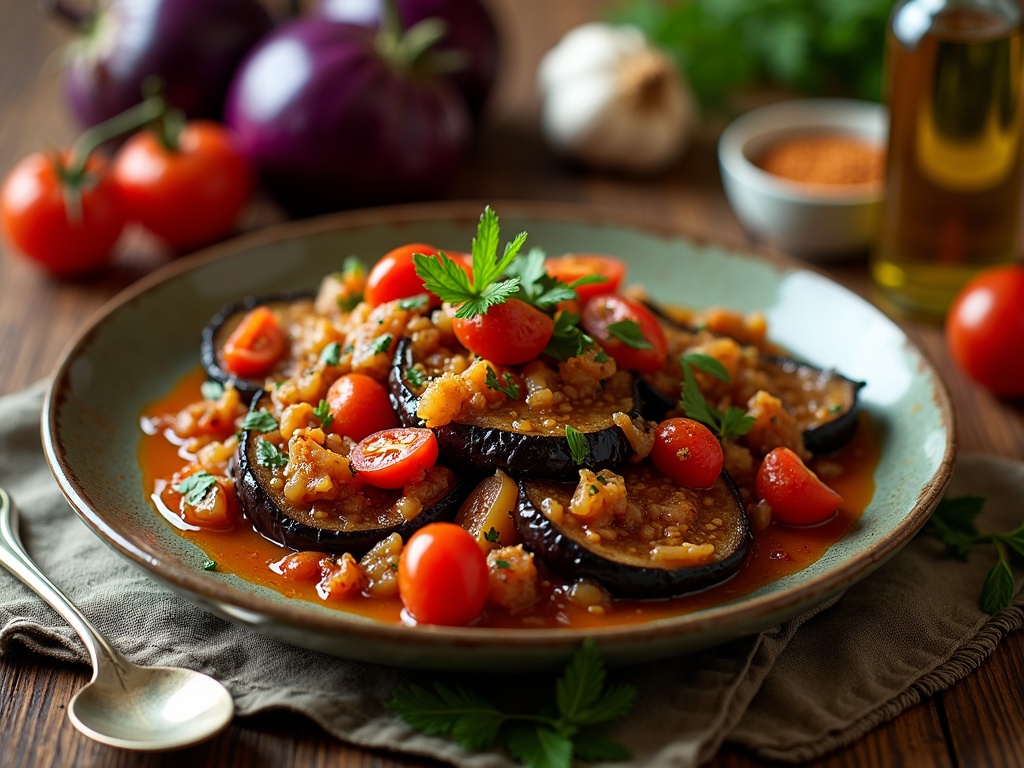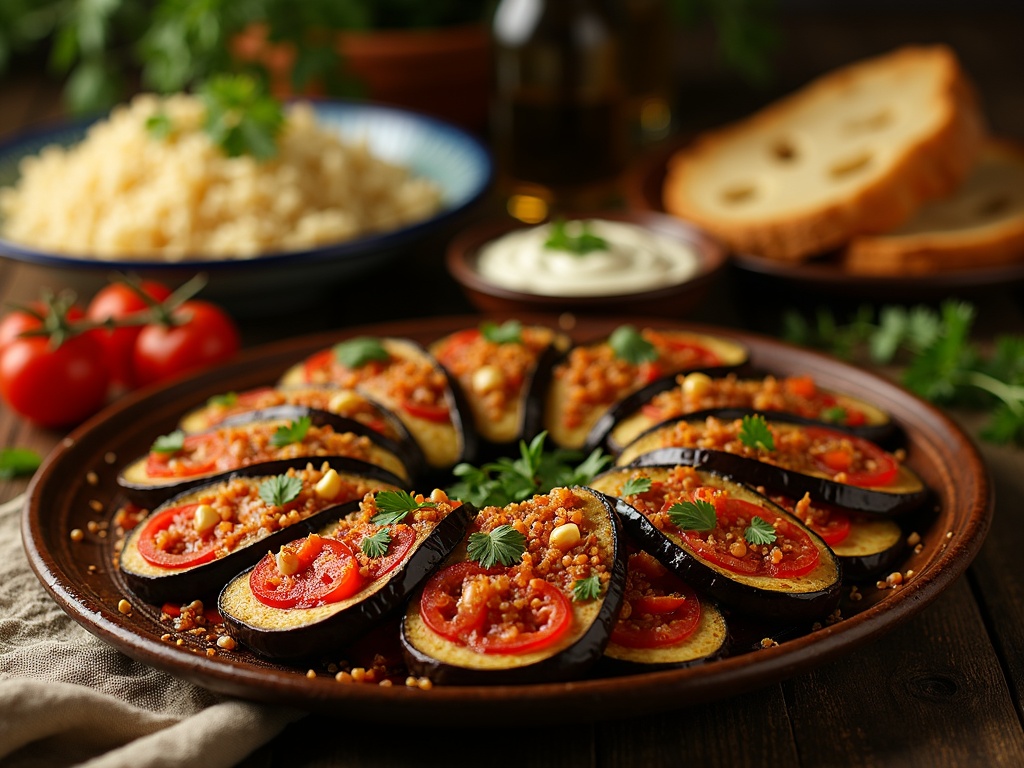Imam Bayildi, a traditional Turkish eggplant dish whose name literally translates to “the imam fainted,” combines tender eggplants with a rich filling of onions, garlic, and tomatoes cooked in generous amounts of olive oil. The centuries-old recipe from the Ottoman Empire comes with fascinating origin stories that add to its cultural significance as it has spread throughout Mediterranean and Middle Eastern cuisines.
Find In This Article
Key Takeaways
- The dish’s unusual name reportedly comes from either an imam fainting from the deliciousness or from shock at how much precious olive oil his wife used in preparation.
- Imam Bayildi exemplifies “zeytinyağlı” dishes in Turkish cuisine – vegetables cooked in olive oil and traditionally served at room temperature.
- The dish contains approximately 200-300 calories per serving and provides significant amounts of Vitamin C, dietary fiber, and antioxidants.
- While traditionally slow-cooked, modern variations include oven roasting, grilling, or stovetop methods that reduce cooking time while maintaining flavor.
- Naturally vegetarian and easily made vegan, Imam Bayildi pairs perfectly with rice pilaf, garlic yogurt, and fresh bread for a complete meal.
The Mouthwatering Story Behind ‘The Imam Fainted’
The name “Imam Bayildi” instantly grabs attention when spotted on a menu. Translated from Turkish, it literally means “the imam fainted” – a dramatic title for what appears to be a simple eggplant dish. This intriguing name has been drawing diners to this traditional Turkish delicacy for generations, and there’s a fascinating story behind it.
The Tale Behind the Name
Imam Bayildi emerged during the Ottoman Empire, with its origins dating back to the 19th century. The dish holds a special place in Turkish culinary history and has spread its influence throughout Mediterranean and Middle Eastern cuisine. But why would an imam – a Muslim religious leader – faint over a vegetable dish?
According to the most popular legend, a Turkish imam married a woman whose dowry included twelve jars of the finest olive oil. Being an excellent cook, the bride prepared him a spectacular eggplant dish cooked in olive oil. The imam was so overwhelmed by its delicious taste that he fainted in delight! Another version suggests he fainted upon learning how much precious olive oil his wife had used in preparing this flavorful vegetable delicacy.
Some culinary historians offer a more practical explanation: the imam may have fainted from the richness of the dish, as traditional versions use generous amounts of olive oil that the eggplant readily absorbs. Whatever the true story, the name has stuck for centuries, adding to the dish’s charm and allure.
Cultural Significance and Variations
Imam Bayildi isn’t just any eggplant dish – it represents a significant cultural exchange across the Mediterranean. The dish has traveled beyond Turkey’s borders, becoming a beloved staple in Greek, Lebanese, and other regional cuisines. Each culture has added its own subtle variations while maintaining the core elements that make this dish special.
In Turkey, it’s traditionally served at room temperature as a mezze or side dish. The preparation involves:
- Selecting small, tender eggplants that are carefully slit and stuffed
- Creating a filling of onions, garlic, and tomatoes sautéed in olive oil
- Slow-cooking everything until the eggplants become incredibly tender
- Finishing with fresh herbs like parsley and sometimes a sprinkle of lemon juice
The dish exemplifies the Mediterranean approach to vegetable-centric cooking, where humble ingredients transform into something extraordinary through careful preparation and aromatic spice combinations. It’s also a perfect example of “zeytinyağlı” dishes in Turkish cuisine – vegetables cooked in olive oil and served at room temperature.
What makes Imam Bayildi particularly special is its place in the cultural narrative of the region. Unlike many dishes with forgotten origins, this one comes with its own story, keeping history alive through food. The preparation is somewhat labor-intensive, which has traditionally made it a dish for special occasions or a demonstration of cooking prowess.
Today, you’ll find Imam Bayildi served in homes and restaurants across Turkey and beyond. Modern versions might include additional vegetable varieties or be adapted for quicker cooking methods, but the soul of the dish remains unchanged – tender eggplant, rich olive oil, and a harmony of flavors that might not make you faint, but will certainly leave you wanting more.
A Perfect Blend of Mediterranean Flavors
I’ve found that Imam Bayildi represents the epitome of Mediterranean cuisine with its beautiful harmony of simple, fresh ingredients that create a dish greater than the sum of its parts. The recipe centers around a handful of core ingredients that work together to create layers of flavor and texture.
Essential Components
At the heart of this beloved dish are globe or Italian eggplants, which provide a meaty texture and ability to absorb the rich flavors of the other ingredients. The eggplants are complemented by sweet onions that caramelize during cooking, adding depth and natural sweetness to the dish.
Garlic plays a crucial role, infusing the oil with its aromatic compounds that permeate the entire dish. Fresh tomatoes contribute brightness, acidity, and a natural sweetness that balances the earthiness of the eggplants.
Extra virgin olive oil isn’t just a cooking medium but a fundamental flavor component that brings everything together. I recommend using a good quality olive oil since it significantly impacts the final taste of your vegetable-based dish.
The spice profile of Imam Bayildi is relatively simple but incredibly effective:
- Cumin adds a warm, earthy note that complements the eggplant
- Freshly ground black pepper provides subtle heat and complexity
- Fresh herbs like parsley and mint bring brightness and freshness
Nutritional Benefits
Beyond its incredible flavor, Imam Bayildi offers impressive nutritional benefits. A typical serving contains between 200-300 calories, making it a satisfying yet light meal option or side dish. The eggplant and tomato combination delivers approximately 30% of your daily Vitamin C requirements per serving.
The dish also provides about 10% of your daily dietary fiber needs, supporting digestive health. This makes it a fantastic addition to protein-rich main courses for a balanced meal.
I’m particularly impressed by the high antioxidant content found in this dish. Eggplants contain nasunin, a potent antioxidant found in their skin, while tomatoes provide lycopene, especially when cooked with olive oil, which enhances absorption.
The olive oil itself contributes healthy monounsaturated fats, which can help support heart health when consumed as part of a balanced diet. Garlic brings additional health benefits with its natural antimicrobial and anti-inflammatory properties.
What makes Imam Bayildi truly special is how these flavorful ingredients come together in perfect harmony. The slow cooking process allows the eggplants to become tender while absorbing the flavors of the onion, garlic, and tomato mixture. The result is a dish with complex flavors despite its relatively short ingredient list.
This wonderful vegetarian dish demonstrates how Mediterranean cuisine achieves exceptional flavor through quality ingredients and proper cooking techniques rather than complicated preparations. It’s a perfect example of how traditional recipes have stood the test of time by focusing on seasonal produce and simple cooking methods that allow natural flavors to shine through.

Traditional Preparation Meets Modern Methods
I’ve found that creating authentic Imam Bayildi requires patience, but the reward is a deeply flavorful eggplant dish that captures the essence of Turkish cuisine. The traditional slow-cooking process begins with selecting medium-sized, firm eggplants with glossy skin – these will hold their shape better during cooking.
First, I partially peel the eggplants in stripes, which helps them maintain structure while allowing flavor absorption. After slitting them lengthwise, I soak them in salted water for 30 minutes to remove any bitterness. While they soak, I prepare a rich filling of sautéed onions, garlic, tomatoes, and olive oil, seasoned with cumin and cinnamon.
The eggplants are then stuffed with this mixture and slowly simmered in olive oil and tomato sauce for about 45 minutes until they become meltingly tender. This slow-cooking method allows the eggplants to absorb the flavors completely, creating that characteristic sweet-savory taste profile that complements tangy tomato-based sides beautifully.
Modern Cooking Alternatives
When I’m short on time, I’ve adapted several modern approaches that maintain authenticity while fitting into a busy schedule:
- Oven roasting provides a hands-off approach that’s perfect for multitasking. I arrange the stuffed eggplants in a baking dish, add the sauce and cover with foil before baking at 375°F for 40 minutes. The final 10 minutes uncovered creates a beautiful caramelization on top.
- Grilling adds a smoky dimension to this classic. I grill the whole eggplants until charred and soft, then split, flatten and top with the pre-cooked filling mixture before a final quick grill to meld flavors.
- Stovetop variation involves cutting eggplants into thick rounds rather than splitting them lengthwise. I pan-fry these until golden, then layer them with the filling in a skillet and simmer for just 20 minutes. This technique works particularly well with rich lamb dishes that need a lighter side.
Perfecting Texture and Regional Variations
The ideal Imam Bayildi should have eggplants that remain intact while being tender enough to cut with a fork. I’ve found these tips crucial for perfect texture:
- Salting eggplants draws out moisture and prevents them from absorbing too much oil
- Avoiding excessive stirring during cooking helps maintain structural integrity
- Serving at room temperature allows flavors to develop fully
- Using young, fresh eggplants reduces bitterness and cooking time
Regional variations across the Mediterranean add fascinating twists to this classic. In some parts of Turkey, ground lamb is added to the filling, creating a heartier version that pairs wonderfully with light grain-based sides. Greek interpretations often include cheese like feta sprinkled over the top before serving.
The herb profile can vary significantly too. While parsley is traditional, I’ve experimented with dill for a brighter flavor profile, and mint adds a refreshing quality that works especially well in summer. Northern Turkish versions sometimes incorporate walnuts into the filling, adding texture and richness.
The beauty of Imam Bayildi lies in this adaptability – whether I’m preparing it the traditional way that takes nearly two hours or using a 30-minute modern method, the distinctive combination of eggplant, olive oil, and aromatic vegetables creates a dish that’s both comforting and complex like other vegetable-centric mains from the region.
Making It Your Own: Vegetarian and Vegan Adaptations
Imam Bayildi is naturally vegetarian, making it a perfect dish for those avoiding meat while still craving something hearty and satisfying. The traditional recipe centers around eggplant stuffed with a rich tomato and onion mixture, cooked in olive oil until everything melds into silky perfection. I’ve found this dish to be incredibly adaptable while still honoring its Turkish roots.
Vegan Modifications and Similar Dishes
Converting Imam Bayildi to a vegan version requires minimal changes since the only non-vegan ingredient might be honey sometimes used for sweetness. Simply substitute with a bit of sugar or agave nectar, and you’ll have a completely plant-based delight that doesn’t sacrifice any of the original flavors.
This eggplant dish shares DNA with several Mediterranean and Middle Eastern classics. While Imam Bayildi features stuffed whole eggplants, Baba Ganoush takes a different approach by roasting and mashing eggplant into a dip. The French Ratatouille, meanwhile, combines similar ingredients but presents them as a vegetable stew rather than a stuffed dish. Each maintains the eggplant’s starring role but offers distinct textures and eating experiences.
For those looking to customize while keeping the dish authentic, I’ve found these variations work beautifully:
- Spice adjustments – Add a pinch of cumin or smoked paprika to give your dish a personal signature
- Texture play – Mix in chickpeas or lentils for extra protein and heartiness
- Herb variations – Swap traditional parsley for fresh mint or dill for a bright twist
- Grain pairing – Serve over bulgur or with a side of rice to make a complete meal
When adapting this recipe, it’s important to respect certain fundamental elements. The slow-cooking method allows eggplants to become meltingly tender while absorbing the flavors of olive oil and tomatoes. This cooking technique shouldn’t be rushed, as it creates the signature silky texture that makes Imam Bayildi so beloved.
Common substitutions that work particularly well include:
- Pine nuts or walnuts added to the filling for extra crunch and nutrition
- Bell peppers in place of some tomatoes for a different sweetness
- Zucchini as a partial eggplant substitute for a lighter version
- Fresh tomato sauce instead of diced tomatoes for a smoother filling
I’ve experimented with adding different vegetables to the stuffing mixture with great success. Finely diced carrots bring natural sweetness, while spinach adds color and nutrients. For those seeking additional protein, crumbled tofu works surprisingly well within the vegetable mixture, absorbing the aromatic flavors while adding substance.
The beauty of Imam Bayildi lies in its simplicity and flexibility. You can make it as traditional or contemporary as you like, all while enjoying its fundamental vegetarian nature. The dish’s legendary name—translating to “the imam fainted” supposedly because of its deliciousness—reminds us that sometimes the simplest plant-based recipes can deliver the most impressive results.
For a heartier adaptation, consider serving alongside a spiced rice pilaf or warm flatbread to soak up the flavorful olive oil. A sprinkle of fresh herbs just before serving brings brightness to this richly flavored dish, completing an adaptation that honors tradition while embracing modern dietary preferences.

Perfect Pairings and Serving Suggestions
Imam Bayildi is a dish that truly shines when paired with complementary sides that balance its rich, olive oil-infused flavors. I’ve found that this classic Turkish eggplant dish can transition from a simple family meal to an impressive dinner party centerpiece with just a few thoughtful accompaniments.
Traditional Accompaniments
The most authentic way to serve Imam Bayildi is alongside fluffy rice pilaf. The neutral, slightly buttery taste of well-prepared rice pilaf creates the perfect canvas for soaking up the flavorful olive oil and tomato juices from the eggplant. I prefer using long-grain rice cooked with a touch of butter and subtle spices like bay leaf or cardamom.
Garlic yogurt provides a cooling contrast to the warmth of Imam Bayildi. To prepare this simple accompaniment, I mix thick Greek yogurt with crushed garlic, a pinch of salt, and sometimes a sprinkle of dried mint. The tanginess cuts through the richness of the eggplant dish while the creamy texture adds another dimension to each bite.
Fresh bread is another must-have pairing. Whether it’s warm pita, crusty sourdough, or traditional Turkish bread, having something to mop up the delicious olive oil sauce is essential for a complete experience.
Expanding Your Menu
Green salads offer a refreshing counterpoint to the soft texture of Imam Bayildi. I recommend a simple salad with crisp lettuce, cucumber, and tomatoes dressed with lemon juice and olive oil. For something more substantial, try a tomato-based side that complements the similar flavors in the main dish.
For a more elaborate spread, consider adding:
- Hummus or baba ganoush for additional dipping options
- Stuffed grape leaves (dolmas) for a traditional meze platter feel
- Roasted bell peppers to complement the sweet onion flavors
- Light appetizers like olives and pickled vegetables
- A vegetarian curry if serving as part of a larger vegetarian feast
Imam Bayildi pairs beautifully with both red and white wines, particularly those from the Mediterranean region. A crisp Turkish white or a light Greek red works wonderfully, as does sparkling water with lemon for a non-alcoholic option.
The dish can be served warm, at room temperature, or even chilled, making it incredibly versatile. I prefer serving it slightly warm or at room temperature, as this allows the flavors to fully develop and meld together.
For presentation, I place the eggplant halves on a large platter, slightly overlapping, and drizzle any remaining sauce over the top. A scattering of fresh herbs like parsley or mint adds color, while a final drizzle of your best olive oil brings shine and flavor. For extra visual appeal, consider serving on colorful ceramic plates or alongside vibrant side dishes that create contrast.
When hosting guests, I sometimes place individual portions of Imam Bayildi alongside small mounds of rice pilaf, with the garlic yogurt in a separate small bowl. This creates a composed plate that highlights the care taken in preparing this flavorful vegetarian main course.
For family-style dining, simply place everything in the center of the table and let everyone help themselves—the informal approach often leads to the most enjoyable meals and conversations around this beloved eggplant dish.

Cultural Impact and Global Recognition
Imam Bayildi carries profound cultural significance in Turkish society, especially during important gatherings and religious observations. I’ve noticed how this eggplant dish takes center stage at family tables during Ramadan, where it’s cherished not just for its rich flavors but for the communal experience it creates. During this holy month, the dish serves as both a satisfying iftar option and a connection to culinary heritage that brings families together.
The international restaurant scene has embraced this Turkish classic with open arms. What was once a regional specialty has found its way onto menus from New York to Sydney. High-end Mediterranean restaurants feature gourmet versions with artistic presentations, while casual eateries offer more rustic interpretations that stay true to the dish’s humble origins. The popularity of Middle Eastern cuisine has helped elevate this dish from obscure ethnic food to mainstream favorite.
Media Presence and Global Appeal
Celebrity chefs and cooking shows have played a crucial role in introducing Imam Bayildi to international audiences. The dish regularly appears in:
- Television cooking competitions highlighting international cuisine
- Food travel shows exploring Turkish culinary landscapes
- Online cooking tutorials and food blogs celebrating vegetarian dishes
- Social media platforms where its photogenic appearance makes it highly shareable
Modern cookbooks increasingly feature this eggplant dish as authors explore authentic Turkish recipes. The visual appeal of the glossy, tender eggplant stuffed with colorful vegetables makes it a favorite for cookbook photography.
The rising global interest in Mediterranean cooking has significantly boosted Imam Bayildi’s profile. Its alignment with several contemporary food trends has proven perfect timing for its international emergence. The dish naturally fits with the growing demand for plant-based meals, offering a satisfying vegetarian option that doesn’t sacrifice flavor. Its health benefits align perfectly with the Mediterranean diet’s growing reputation for promoting wellness.
In traditional Turkish dining experiences, Imam Bayildi occupies a special place. It’s typically served as a “zeytinyağlı” dish – meaning cooked with olive oil and served cold or at room temperature. This makes it part of the “meze” tradition, where multiple small dishes are shared among diners, creating an interactive and communal dining experience. The dish fits perfectly into the Turkish concept of “keyif” – the art of taking pleasure in life’s simple enjoyments.
I’ve found that Imam Bayildi exemplifies the cultural exchange that happens through food. While maintaining its authentic Turkish roots, adaptations have emerged that incorporate local ingredients or techniques. Some chefs add tomato-based sauces or regional spice blends while preserving the dish’s essence.
Home cooks around the world have embraced Imam Bayildi as they explore global cuisines. The accessibility of ingredients like eggplant, tomatoes, and olive oil in most markets has made this once-exotic dish approachable for everyday cooking. Its make-ahead quality also appeals to busy modern lifestyles, as the flavors actually improve when allowed to meld overnight.
The story behind the dish’s name – “the imam fainted” – adds an element of cultural storytelling that resonates with food enthusiasts. Whether the imam fainted from delight at the taste or shock at the amount of olive oil used, this narrative element has helped the dish capture imagination beyond its flavors alone.
Sources:
“The Complete Mediterranean Cookbook” by America’s Test Kitchen
“Turkish Cookery” by Ghillie Başan
“Mediterranean Diet: The Complete Guide” by Craig E. Johnson

